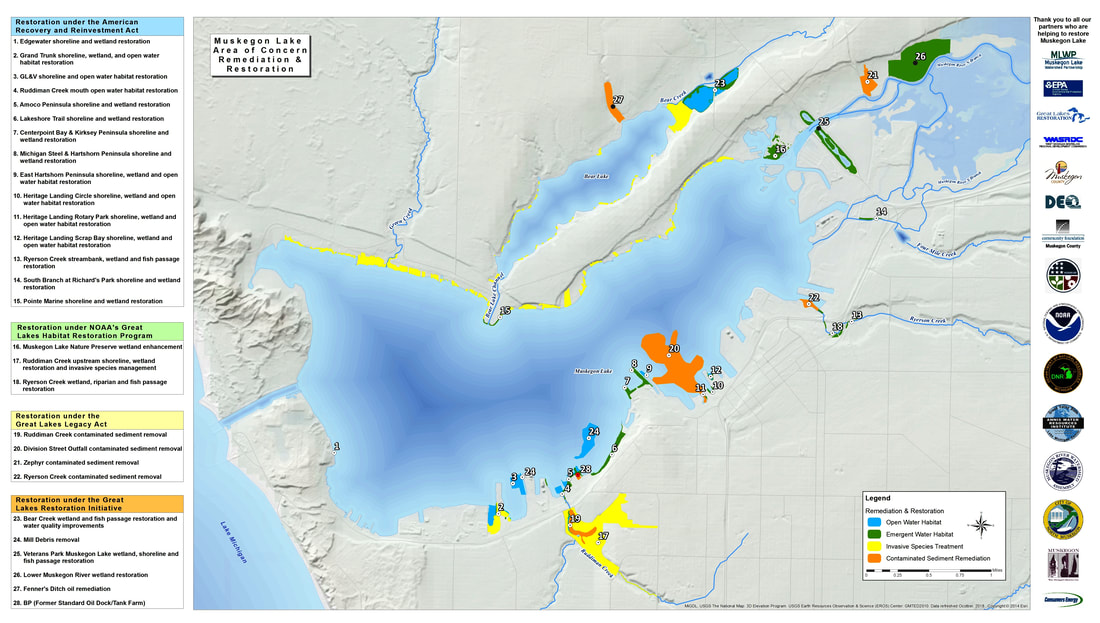Division Street Outfall is a very big piece of the restoration of Muskegon Lake....
It's a big victory for Muskegon, it's a big victory for West Michigan, and it's a big victory for the Great Lakes.
- Cam Davis, Great Lakes Advisor to the EPA Administrator, 2012
The sediment cleanup at the Division Street Outfall is complete!
The sediment cleanup on Muskegon Lake near Division Street Outfall is complete! A Great Lakes Legacy Act (GLLA) project in 2011 removed 43,000 cubic yards of contaminated sediment. An extensive sand cover was placed to further contain any residual contamination, limit the potential for direct contact with aquatic life, and provide a habitat-friendly growing medium for bottom-dwelling benthic critters and plants.
The environmental cleanup work at Division Street Outfall is part of a larger effort to revitalize the Muskegon Lake Area of Concern. Local investment in the land adjacent to the remediated area is already taking place. Rotary Park was constructed and primarily funded through private, local donors. It features a handicap-accessible playground, fishing bridge, and kayak launch.
The environmental cleanup work at Division Street Outfall is part of a larger effort to revitalize the Muskegon Lake Area of Concern. Local investment in the land adjacent to the remediated area is already taking place. Rotary Park was constructed and primarily funded through private, local donors. It features a handicap-accessible playground, fishing bridge, and kayak launch.
Location
The GLLA cleanup of Muskegon Lake took place at the Division Street Outfall near the Hartshorn Marina and Heritage Landing. Workers mechanically dredged contaminated sediment and placed a six to 12-inch sand cover over 60 acres of lake bottom, including the dredge area.
|
The Division Street Outfall cleanup site is located in Muskegon, MI on the eastern end of Muskegon Lake. The site is located within the Muskegon Lake Area of Concern.
|
Cleanup Process
Sediment remediated: 43,000 cubic yards
Contaminants: mercury, oil and grease, PAHs Method: Mechanical dredging and sand cover When: 2011-2012 Partners: U.S. Environmental Protection Agency and Michigan Department of Environmental Quality Cost: $10.8 million Notes: Dredged sediment was transported to Ottawa County Farms Landfill. The project included shoreline restoration with invasive species removal and the planting of native flowers, grasses, and bushes. |
|
Long-term Benefits
- The cleanup reduced mercury contamination from the watershed's food chain, which over time will lessen exposure for people who eat fish from Muskegon Lake. It may take years before fish advisories in Muskegon Lake are less restrictive.
- Shoreline restoration improved visibility of the lake for waterfront property in the area.
- The cleanup and restoration of Muskegon Lake have contributed to community revitalization in Muskegon. Learn about Muskegon’s revitalization, including its waterfront events and housing.
More Information
Documents and Resources
Great Lakes Areas of Concern: Six Strategies to Support Community Revitalization (PDF, 8p, 987KB) 2024
Muskegon’s Revitalization: The Muskegon Lake Area of Concern (video, 4:33), 2022
Eat Safe Fish in Muskegon County (PDF, 2p, 2.3MB) December 2015
Muskegon Lake boater cards (PDF, 2p, 1.18 MB) September 2011
Division Street Outfall fact sheet (PDF, 2p, 334 KB) September 2011
Great Lakes Areas of Concern: Six Strategies to Support Community Revitalization (PDF, 8p, 987KB) 2024
Muskegon’s Revitalization: The Muskegon Lake Area of Concern (video, 4:33), 2022
Eat Safe Fish in Muskegon County (PDF, 2p, 2.3MB) December 2015
Muskegon Lake boater cards (PDF, 2p, 1.18 MB) September 2011
Division Street Outfall fact sheet (PDF, 2p, 334 KB) September 2011





